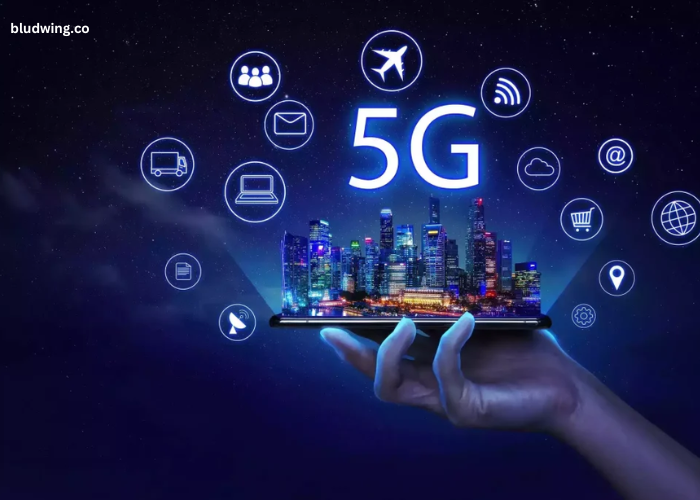The 5G revolution is here, and it’s set to reshape the way we connect, communicate, and interact with the world. As the fifth generation of wireless technology, 5G promises to deliver faster speeds, lower latency, and more reliable connections than ever before. This leap in technology will not only revolutionize communication but also have a profound impact on industries, economies, and everyday life.
Unlike previous generations, 5G is designed to accommodate the growing demand for data and the increasing number of connected devices, such as smartphones, smart homes, self-driving cars, and the Internet of Things (IoT). In this article, we’ll explore how the 5G revolution is changing the world, from transforming industries to enhancing everyday experiences, and what it means for the future.
Key Points:
- 5G promises ultra-fast data speeds, low latency, and improved connectivity.
- The 5G network will support the growing number of connected devices and technologies.
- 5G is expected to transform industries such as healthcare, transportation, and entertainment.
How is 5G Technology Different from 4G?
Before diving into the revolution brought by 5G, it’s essential to understand how it differs from its predecessor, 4G. While 4G revolutionized mobile internet by providing fast speeds and reliable connections, 5G takes things to the next level.
1. Speed and Bandwidth
The most noticeable difference between 4G and 5G is speed. 5G can deliver data speeds up to 100 times faster than 4G, allowing users to download large files, stream ultra-high-definition videos, and use bandwidth-intensive applications with ease. With 5G, download speeds can reach up to 10 gigabits per second (Gbps), compared to 4G’s maximum of 100 megabits per second (Mbps).
This dramatic increase in speed opens up new possibilities for industries, businesses, and consumers. Imagine downloading an entire movie in seconds or using augmented reality (AR) and virtual reality (VR) applications without lag. The enhanced speed and bandwidth of 5G will transform the way we interact with technology.
2. Latency and Responsiveness
5G offers incredibly low latency, or the time it takes for data to travel from one point to another. While 4G has a latency of around 50 milliseconds, 5G can reduce this to as low as 1 millisecond. This means near-instant communication between devices and a smoother experience for applications that require real-time data, such as remote surgeries, autonomous vehicles, and online gaming.
The reduced latency makes 5G ideal for time-sensitive applications, where every millisecond counts. Whether it’s controlling robotic systems remotely or enabling faster reaction times in autonomous cars, 5G’s low latency will allow for innovations that were once thought to be impossible.
3. Capacity and Connectivity
Another major advantage of 5G is its ability to handle more devices simultaneously. With 4G, the number of connected devices that can be supported by a network is limited. As the number of connected devices continues to grow—thanks to the rise of IoT—4G networks could become congested, leading to slower speeds and interruptions.
5G, on the other hand, is designed to handle up to one million devices per square kilometer. This is particularly important as cities become more connected, and more devices, such as smart appliances and wearables, come online. The increased capacity of 5G ensures a seamless connection even in densely populated areas.
How Will 5G Revolutionize Industries?
The 5G revolution will have a far-reaching impact on various industries, unlocking new possibilities and improving efficiency, safety, and innovation.
1. Healthcare: Remote Healthcare and Surgery
In the healthcare industry, 5G technology has the potential to save lives. With ultra-low latency and fast data transfer speeds, 5G can enable telemedicine and remote surgeries that were previously impossible. Surgeons will be able to perform procedures remotely with real-time feedback, while patients in rural or underserved areas can access healthcare services without having to travel long distances.
5G-powered devices can also improve diagnostics, allowing for quicker and more accurate results. Wearables that track vital signs can send data in real time to healthcare providers, ensuring prompt intervention when necessary.
2. Transportation: Autonomous Vehicles and Smart Cities
The transportation sector is another area that will benefit from 5G technology. Autonomous vehicles (self-driving cars) rely on instant communication between vehicles and infrastructure to navigate safely. With 5G’s low latency, autonomous cars can react to changes in their environment almost instantaneously, reducing the risk of accidents and improving road safety.
In addition, 5G will play a crucial role in the development of smart cities, where connected infrastructure and services work together to enhance urban living. Traffic lights, street sensors, and public transportation systems will be connected through 5G, allowing for better traffic management, improved safety, and more efficient public services.
3. Entertainment: Enhanced Experiences and Streaming
The entertainment industry will also see significant improvements thanks to 5G technology. Faster speeds and lower latency will enhance streaming services, enabling seamless HD and 4K video streaming on mobile devices. Virtual and augmented reality experiences will become more immersive, as 5G provides the bandwidth needed to support these data-heavy applications.
For example, 5G will allow for real-time AR and VR gaming, where players can interact with virtual worlds in an instant without experiencing any lag or delay. This enhanced experience will take entertainment to a whole new level, offering new ways to consume media and interact with content.
4. Manufacturing: Smart Factories and Automation
5G is poised to revolutionize the manufacturing industry by enabling smart factories. With real-time data transfer and low latency, manufacturers can implement automation systems that operate efficiently and safely. Robots and machinery can communicate with each other in real time, improving production lines and minimizing downtime.
Additionally, 5G will support the use of augmented reality in manufacturing, allowing workers to access real-time instructions and information while on the job. This will improve safety, reduce errors, and increase overall productivity.
What Challenges Does the 5G Revolution Face?
While the potential benefits of 5G are immense, there are several challenges that must be addressed before it can fully realize its potential.
1. Infrastructure and Deployment
One of the biggest challenges in rolling out 5G is the need for new infrastructure. 5G requires a denser network of small cells (miniature cell towers) to deliver reliable coverage, especially in urban areas. This infrastructure is expensive and time-consuming to deploy, requiring cooperation between governments, telecom companies, and technology providers.
2. Security and Privacy
As 5G enables more connected devices, the risk of cybersecurity threats and privacy concerns increases. With sensitive data being transmitted across a wide range of devices, protecting personal information and ensuring secure communication will be paramount. Governments and tech companies must work together to implement robust security protocols to mitigate these risks.
3. Cost and Accessibility
The cost of upgrading to 5G infrastructure is substantial, and it may take years before 5G is widely available in rural or underserved areas. Access to affordable 5G technology will be crucial to ensuring that the benefits of 5G are accessible to everyone, not just those in major cities.
Conclusion: Embracing the Future with 5G
The 5G revolution represents a monumental leap in wireless technology, with the potential to transform industries, enhance connectivity, and improve everyday life. As 5G networks continue to roll out globally, we can expect faster, more reliable communication and innovations that will redefine how we live, work, and play.
While there are challenges to overcome, the promise of 5G is clear. From healthcare to entertainment, manufacturing to transportation, 5G will unlock new possibilities and pave the way for a smarter, more connected world. As we embrace the 5G revolution, we move closer to a future where technology and connectivity enhance every aspect of our lives.
FAQ’s
1. What is 5G technology?
5G is the fifth generation of wireless technology, offering faster speeds, lower latency, and higher capacity compared to previous generations like 4G.
2. How fast is 5G?
5G can deliver speeds up to 100 times faster than 4G, with download speeds reaching up to 10 Gbps.
3. How will 5G impact healthcare?
5G will enable remote healthcare, telemedicine, and even remote surgeries, improving access to healthcare and allowing for faster and more accurate diagnoses.
4. What industries will benefit from 5G?
Industries such as healthcare, transportation, entertainment, manufacturing, and smart cities will all benefit from the enhanced capabilities of 5G technology.
5. What challenges does 5G face?
Challenges include the cost of deploying 5G infrastructure, security concerns, and ensuring that 5G is accessible to all regions, including rural and underserved areas.




